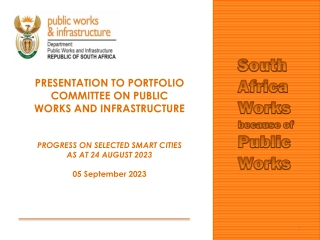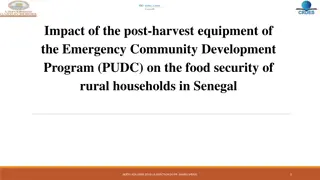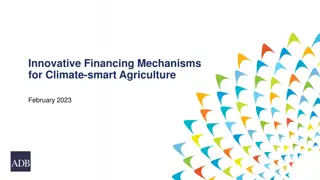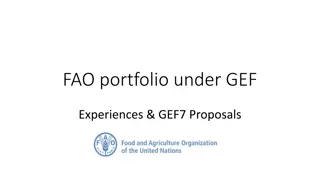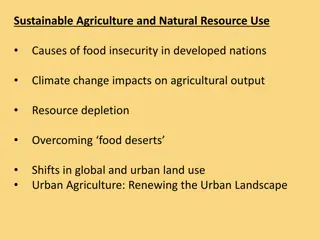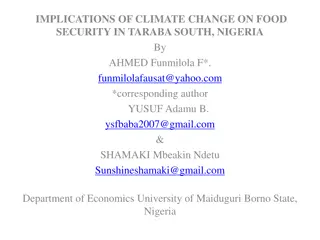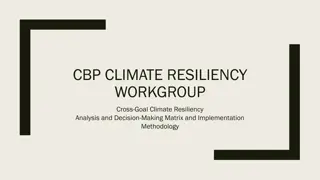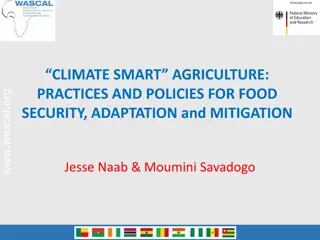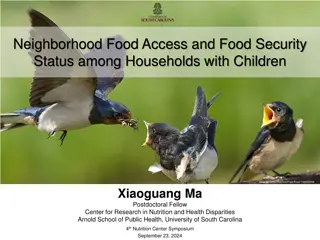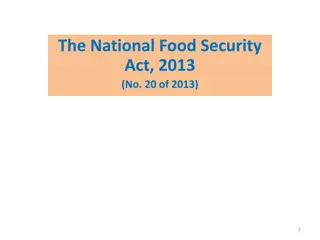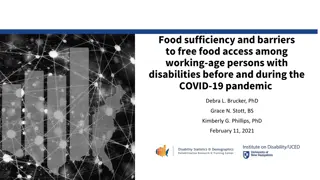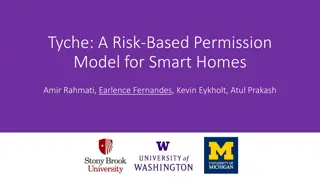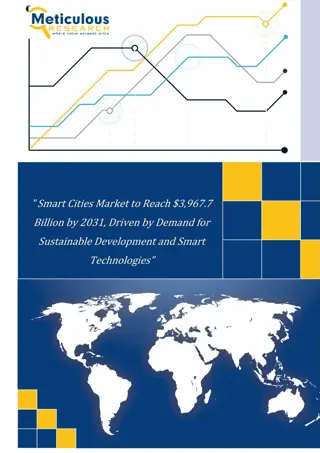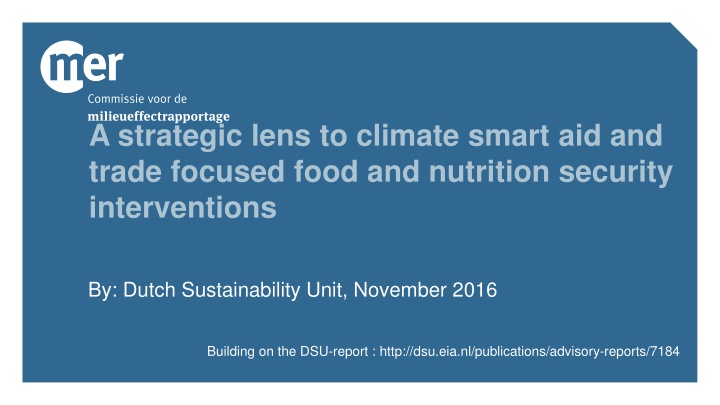
Strategic Climate-Smart Interventions for Food Security
This report explores strategic approaches to climate-smart aid and trade interventions for food and nutrition security, emphasizing climate change adaptation and budget considerations for sustainable development and inclusive growth agendas.
Download Presentation

Please find below an Image/Link to download the presentation.
The content on the website is provided AS IS for your information and personal use only. It may not be sold, licensed, or shared on other websites without obtaining consent from the author. If you encounter any issues during the download, it is possible that the publisher has removed the file from their server.
You are allowed to download the files provided on this website for personal or commercial use, subject to the condition that they are used lawfully. All files are the property of their respective owners.
The content on the website is provided AS IS for your information and personal use only. It may not be sold, licensed, or shared on other websites without obtaining consent from the author.
E N D
Presentation Transcript
A strategic lens to climate smart aid and trade focused food and nutrition security interventions By: Dutch Sustainability Unit, November 2016 Building on the DSU-report : http://dsu.eia.nl/publications/advisory-reports/7184
2 Why this DSU-advice DGIS looking for a practical method to take climate change into consideration from the start of portfolio development. The method should focus on budgets earmarked for food security objectives (SDG2 and SDG3), and, at the same time, objectives of climate change (SDG13). The method doesn t have to be perfect, but should, in a practical way, inform strategic decisions about where to invest future FNS budgets in accordance with the more general aid and trade and inclusive green growth agendas. Focus should be primarily on climate change adaptation rather than climate change mitigation, as adaptation has a closer link to food production and therefore indirectly to accommodation-in-the-region of refugees and prevention of migration.
3 Where to focus interventions with a view to food systems in places where that creates most food security (SDG2) in view of climate change vulnerability (SDG13) and (nearby) conflict (SDG16)? The issue Interventions NL (or other donors and international investors) Sustainable Development impacts (Inter)national Economic systems Climate impact SDG 13 - Priority: Adaptation Other SDGs, ip 1 No poverty, 2 No hunger 3 Good health 5 Gender equality 6 Clean energy 8 Decent work 9 Industry 10 Less inequality 11 Sustainable cities 12 Responsible value chains 13 Climate mitigation 15 Life on land 16 peace, justice .. Bilateral ODA Multilateral ODA Food systems Private investments Climate refugees, Migration Several SDGs
4 Climate change adaptation action: Intends to reduce the vulnerability of people or ecosystems to the current and expected impacts of climate change, including climate variability. It consists of actions to: maintain or increase resilience through increased ability to adapt to, or absorb climate change stresses, shocks and variability help reduce exposure to climate change stresses, shocks and variability Source: DGIS guidelines for integrating climate-smart actions into development activities (Draft 30/10/2016)
5 Climate vulnerability: key factors Location some areas are more vulnerable to the effects of climate change than others Diversity of livelihoods and resources - diversity of resources (income, land, savings) increases the capacity for coping and adapting to climate change. The more resources the lower the vulnerability, especially if less at risk from the effects of climate change. The less resources, the higher the vulnerability. This explains why the poorest (those with limited or no access to resources and income) are the most vulnerable. Gender - Gender influences the dynamics of vulnerability. ( ) Source: DGIS internal guidelines for integrating climate-smart actions into development activities (Draft 30/10/2016)
6 The concept introduced
7 The smart simplification concept, operationalized Areas with high, medium and low potential for climate smart interventions into food systems
8 What does high potential mean? High potential are areas where leverage of interventions is highest in terms of food production and economic output High potential areas are assumed to have both: High dynamics of food systems (e.g. population growth and growing production) Low climate dynamics (less vulnerable to climate change) Assumption behind inclusive green growth and aid to trade policies is that populations from lower potential areas may benefit indirectly through e.g.: radiating multiplier effects, internal migration, or social safety nets
9 Informing strategic portfolio decisions Focusing on these high potential areas, in the above definition, may contribute to the climate resilience of the region as a whole if populations in nearby lower potential areas profit as well. Designing the portfolio intentionally in this way might be considered climate smart and perhaps principal according to Rio Markers. However, alternatively, high potential areas may (e.g.) be defined as those that have high climate dynamics and low food system dynamics. Many vulnerable people live here. They may also be more difficult to help. Interventions may not lead to livelihoods that sustain in the long term. Also growth and trade may profit less. But these things cannot easily be generalized. In any case, the method permits discussion about such possible assumptions, enabling informed portfolio choices. Another source are the climate change profiles of partner countries (downloadable at www.dsu.eia.nl)
10 Linking potential to refugees Among high potential areas one may prioritize areas that are close to potential conflict areas that may benefit from the nearby presence of a food basket This distance could not be integrated into GIS-map and needs to be taken from ad hoc sources, forecasting indirect benefits by expert judgment. In that judgement, experts should take climate change itself into consideration as one exacerbating factor behind conflict. (e.g. ND-GAIN index). The indirect effect on risk of migration to Europe is hard to assess. However, in the long term, green growth in the region probably will reduce that risk as well.
11 The concept further explained
12 System levels we may intervene in Interventions at Food System Level: which food systems (high potential areas) to address (programme location)? Lens 2 Interventions at Value chain level: how to address the enabling environment of these food systems? (programme enabling activities) Interventions at Farming Systems level: how to address the choice of farming systems within food systems? (programme activities) Lens 1 Interventions that do not affect the other 3 system levels above : how to fine-tune programmes with given location and activities in order to cope with climate change? See also climate lens 1 project see http://dsu.eia.nl/publications/advisory-reports/7136)
13 Eligibility under OECD Rio Markers (revised 2016) An activity (DSU: intervention) is adaptation-related if it intends to reduce the vulnerability of human or natural systems to the current and expected impacts of climate change, including climate variability, by maintaining or increasing resilience, through increased ability to adapt to, or absorb, climate change stresses, shocks and variability and/or by helping reduce exposure to them. This encompasses a range of activities from information and knowledge, generation, to capacity development, planning and the implementation of climate change adaptation actions. An activity is eligible to the marker if the climate change adaptation objective is explicitly indicated in the activity documentation; and the activity contains specific measures targeting the definition above.
14 The two spatial determinants Food system dynamics: Expected leverage (relevant conditions: nearby food demand, ongoing urbanization, infrastructure/access, etc) Climate dynamics: Climate vulnerability: a changing climate + susceptible to being adversely affected (relevant conditions: water availability, temperature, agricultural land use, quality of governance ..)
Four types of areas with names from green growth / aid to trade perspective 15 Food system dynamics Low Medium potential interventions (yield may be increased but demand is not growing as much) Physical potential but less market potential Low potential interventions (preserving local systems that have little yield potential at high cost) Flogging a dead horse High High potential (strong investment potential, relatively easy physical conditions) High Medium potential for FNS High potential for FNS interventions Low High economic and resilience economic and resilience leverage leverage Physical potential but less market potential Low potential for FNS Climate dynamics Medium potential interventions (investment potential is high, but agro-ecological conditions make it difficult) Market potential but less physical potential Medium potential for FNS High Flogging a dead horse Market potential but less physical potential
16 Food system dynamics: available proxies (10 km x 10 km, open source, worldwide) Proxy composed of: Urban / rural regions Market access
17 Climate dynamics: available proxies (10 km x 10 km, open source, worldwide) Proxy composed of Water availability (based on precipitation; irrigation, drought risk, proximity of rivers and lakes) Agricultural land use (Share of cropland, Cattle density, Share of pastures) The combination of water availability and current agricultural land use is assumed to be an adequate first-order estimate of climate vulnerability of the production system. It uses the observed standard deviation of precipitation as measure of climate variability that may be aggravated in the future and then may exceed threshold values, causing climate shocks to the production system. Combined with the accumulated water availability and the type of production (agricultural land use) we have a measure for vulnerability to exceeding of such threshold values. As it is a first-order estimate, it always has to be checked against reality on the ground. In the future, as drilled down and regularly updated climate scenarios become available, it may be possible to refine the risk estimates.

